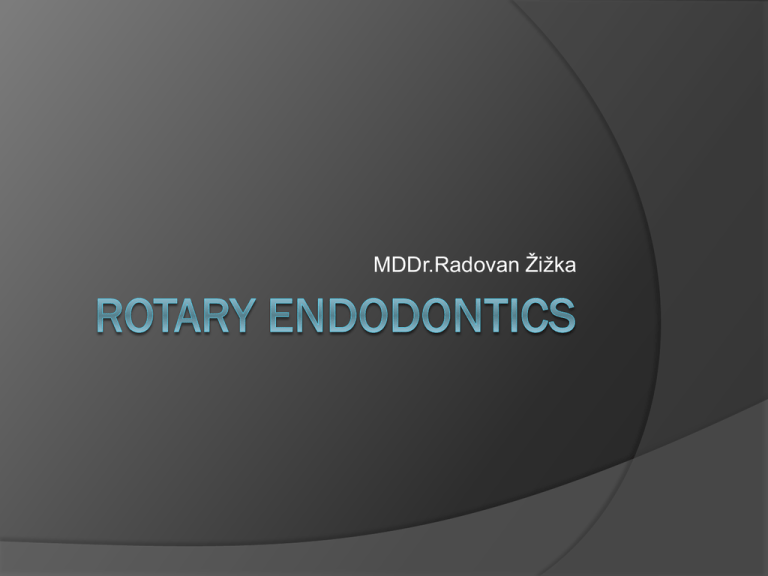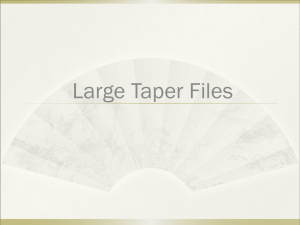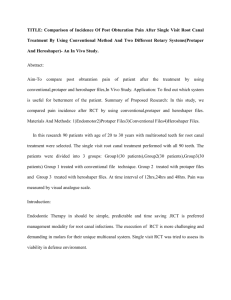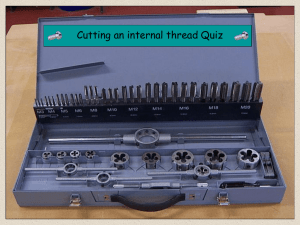Rotary endodontics
advertisement

MDDr.Radovan Žižka Aim of seminary Basic information about Ni-Ti alloy Dividing NiTi rotary instruments Tip configuration Cross-sectional design Flute design Rake angle Taper Principles o NiTi instruments Fracture prevention of NiTi instruments Techniques used with NiTi files NiTi alloy 1963 – developed for space program by Buehler at Naval Ordonance Laboratory in Silver Springs, Maryland, USA Very low elastic modulus (permit negotiation of curved canals) Superelastic behavior Shape memory Tip configuration Cutting Transportation of canal in less experienced hands Making apical seal and obturation difficult Going long with it, creates an elliptical tear at the end of the root Non cutting Reduces the risk of ledging,scratching or gouging Making apical seal and obturation easier Going long with it, creates concentric circle at the end of the root Cross sectional design Triangular Square U shape S type Convex triangle Proprietary ones Flute design part 1 Landed flute design(with radial lands) Radial land Cutting edges had been flattened (named radial lands), U-file design Instruments have to be pushed with light pressure to engage the perimeter of the canal and then cut the dentin there Make preparation slower but safer Increase strenght and decrease flexibility Good centering of instrument, preventing binding or screwing to dentin U shape Flute design part 2 Non-landed flute design Sharp cutting edges resulting from a traingular cross sectional design that cuts more rapidly but can lead also to preparation errors Consider more efficient but require more operator skill to avoid procedural mishap compared to radial-landed files More flexible Others Sharp cutting edge Rake angle Is the angle formed by the cutting edge and a cross section taken perpendicular to the long axis of the instrument Possitive rake angle Shave dentin Negative rake angle Scrape dentin Neutral rake angle Plan dentin Principles of NiTi part 1 Not use as pathfinder Should not be used to negotiate small calcified canals or curved canals because of its non cutting tip Should not be used to bypass ledges Should not be applied with pressure Should not be used for estimating working lenght (stainless steel instruments are more opaque) Principles of NiTi part 2 Need more flaring of access to decrease fatigue of file Must be used in a lubricated canal to reduce frictional resistance Should not be used in abrupt curves, Sshapes and canals that join Once the instrument starts to wobble in the handpiece, the file should be disposed off Principles of NiTi part 3 When NiTi experiences any undue stress including cyclic fatigue, the metal undergoes a crystalline (microscopic) phase transformation and become structurally weaker Cutting efficiency decreases with repeated sterilization(prone to fracture) NiTi file may disarticulate without any warning especially if not properly used Each instrument should not be used more than 5-10 secunds only Fracture prevention of NiTi rotary instruments part 1 Use only torque controlled handpiece Establishing of proper glidepath Use of crown-down technique Frequent cleaning of flutes Do not force the file apically against resistance Remove the maximum possible pulp tissue with broach before using rotary files Fracture prevention of NiTi rotary instruments part 2 Canals should be well lubricated (no dentin mud which increase the risk of fracture) Discard the file if it is bent, stretched, has shiny spots or wobbles in handpiece Do not use rotary files to true working lenght especially in teeth with S-shaped canals, sharp curves Frequently inspect file flutes under magnification Types of rotary instruments according to tapering Tapered Constant - the diameter increases in a constant manner (Profile) Progressive - the diameter increases in a progressive manner (ProTaper) Variable - whether increaes in a variable manner (S1,S2) or increases then decrease (SX, finishing files) Non-tapered Techniques that might be used for rotary instrumentation Crown-down pressureless method Modified crown down method Graduating taper method Starting with smaller tapered instruments, where each instrument is taken to the full working lenght and then proceeding with larger tapers (tip size is constant) Step-back method Modified step-back method Use of Lightspeed system ProTaper Is one of widely used NiTi system today Innovations which characterize ProTaper: Progressive/variable taper Modified guiding tip(rounded, non-cutting and parabolic shaped tip) Varying tip diameters Convex triangular cross-section (not all of them) A positive rake angle Shorter handle of the file Work longer in superelastic phace than do instruments with U-file design ProTaper instruments 3 shaping and 3 finishing files (and 2 additional finishing files) Shaping SX,S1,S2 Finishing F1,F2,F3 F4,F5 http://www.dentsply.com ProTaper SX SX File (auxiliary shaping file) Tip size – ISO19 Taper -D0-D9 – from ISO 19-ISO 100 -D9-D14 – from ISO100-ISO120 (reduction in taper to increase flexibility) Color code – none Designed to Coronal flaring Relocate the canal away from the external root concavities http://www.dentsply.com ProTaper S1 S1 File Tip size – ISO18,5 Taper - D0-D14 – from ISO 18,5-ISO 120 (Increasibly larger taper) Color code – purple Designed to Preparation coronal 1/3 of root canal http://www.dentsply.com ProTaper S2 S2 File Tip size – ISO20 Taper - D0-D14 – from ISO 20-ISO 110 (Increasibly larger taper) Color code – white Designed to Enlarge and prepare the middle 1/3 in addition to the critical coronal region of the apical 1/3 http://www.dentsply.com ProTaper F1 F1 File Tip size – ISO20 Taper - D0-D3 – 7° taper - D3-D14 – a reduction in taper to increase flexibility Color code – yellow Designed to Primarily to finish apical 1/3 of the canal Expand the middle 1/3 of the canal Plane away the variations in canal diameter after shaping http://www.dentsply.com ProTaper F2 F2 File Tip size – ISO25 Taper - D0-D3 – 8° taper - D3-D14 – a reduction in taper to increase flexibility Color code – red Designed to Primarily to finish apical 1/3 of the canal Expand the middle 1/3 of the canal Plane away the variations in canal diameter after shaping http://www.dentsply.com ProTaper F3 F3 File Tip size – ISO30 Taper - D0-D3 – 9° taper - D3-D14 – a reduction in taper to increase flexibility Color code – blue Reduced cross-section with U-file design Designed to Same as F1 and F2 Rigid and agressive http://www.dentsply.com ProTaper In addition there are F4 (double black, ISO40, initial taper is 6°) and F5 (double yellow, ISO50,initial taper is 5°) Shaping instruments should be used in brushing motion, finishing with just light pressure After each instrument irrigation,establishing patency and reirrigation ProTaper technique Scout coronal 2/3 with K-file ISO 10, ISO 15 (coronal glidepath) Shaping coronal 2/3 with S1,S2 Scout apical 1/3 with K-file ISO 10, ISO 15 – establishing working lenght (apical glidepath) Finishing apical 1/3 with S1,S2,F1…. http://www.dentsply.com Advantages of ProTaper part 1 Patented progressive taper design Fewer files are needed to achieve fully tapered canal Convex triangular section Increase the cutting efficiency Increase tactile sensation Decrease the lateral contact area between file and dentin Decrease torsional load, file fatigue and breakage Advantages of ProTaper part 2 The modified guiding tip can easily follow a prepared glidepath A progressively changing helical angles and balanced pitches Stabilizing each instrument Aiding in debris removal Effectively reducing threading (screwing, grabbing and taper lock) ProTaper Next http://www.dentsply.com







